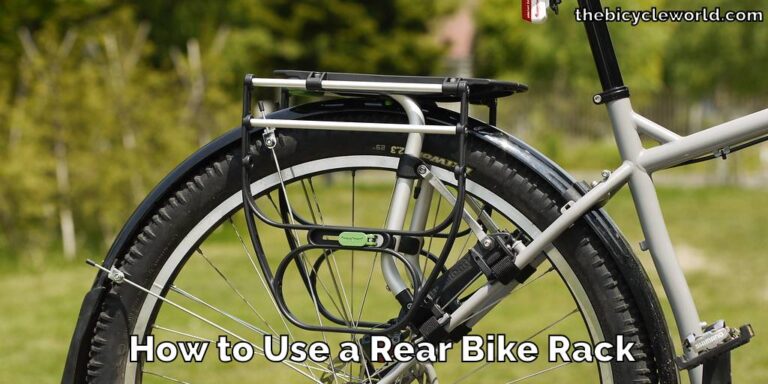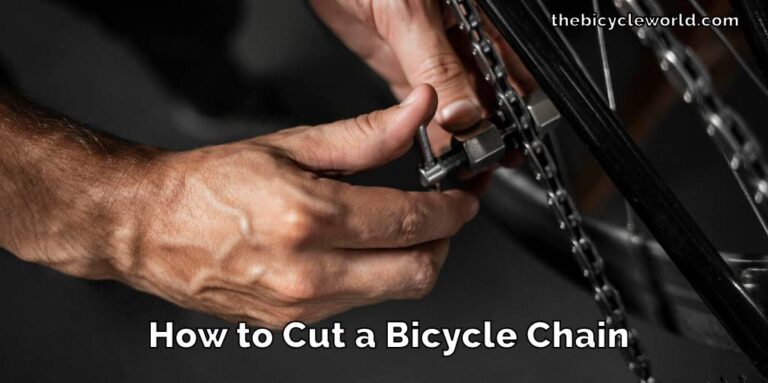How Much Does It Cost to Replace a Bicycle Tire
Replacing an old bike tire is crucial for keeping your ride smooth and safe. Tires wear down or get flats from sharp objects and bumps, so it’s important to know when and “How Much Does It Cost to Replace a Bicycle Tire”.
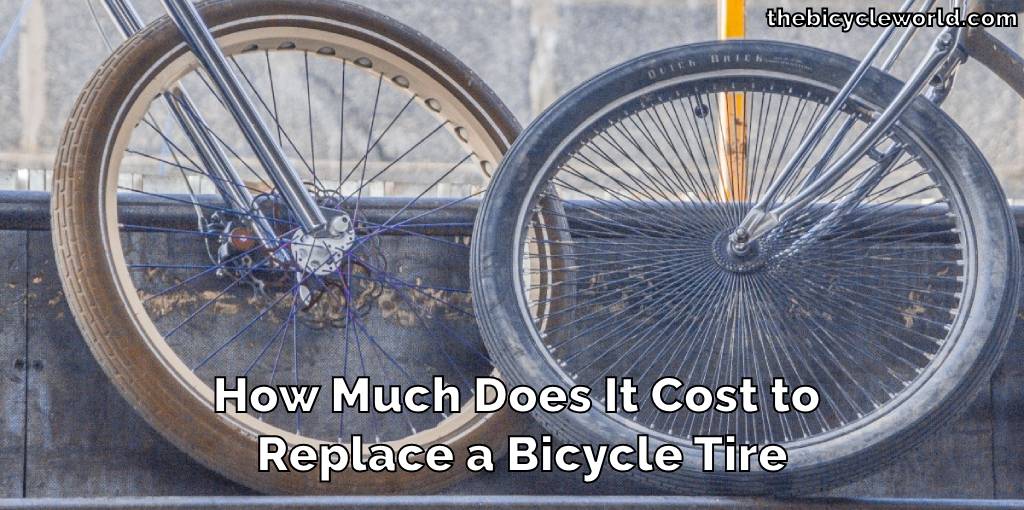
Generally, a new tire costs between ($15 to $50) plus labor if you’re not swapping it yourself, which might be an extra ($10 to $20). High-end or special tires can cost more. This gives you a basic idea of the expenses involved in tire replacement.
Why You Replace a Bicycle Tire
Changing a bicycle tire is something riders do to keep their rides smooth and to avoid any sudden tire problems, like blowouts. Since bicycle tires are always rubbing against the road, carrying the rider’s weight, and facing all sorts of weather, they get worn out. If you don’t replace them, they might not grip the road well, making the bicycle hard to control.
Old or damaged tires can also make pedaling harder and slow you down. People often decide to get new tires when they see signs of wear, like threads showing, or if they keep getting flats. Sometimes, even if a tire looks okay, it might be too old to work well.

Good, sturdy tires make the bicycle feel better to ride, can help you go faster, and use less effort to pedal. It’s all about keeping the bicycle working right and making sure it’s fun and safe to ride.
How Much Does It Cost to Replace a Bicycle Tire
When you need to replace a bicycle tire, the cost can vary a lot depending on a few key things. Here’s what you need to know:
Type of Bicycle
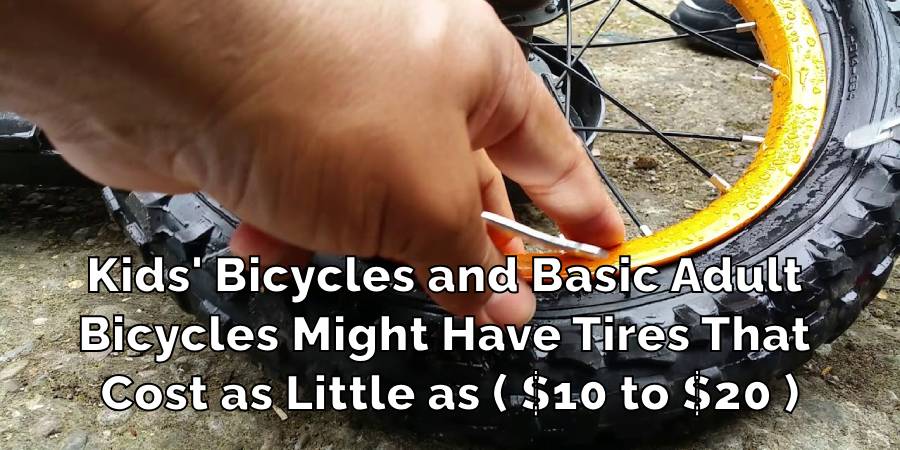
For kids’ bikes and basic adult bikes, tires might cost between $10 and $20. Standard road bikes usually have tires that are a bit more, around $25 to $40. If you have a mountain bike or a high-end road bike, expect to pay $50 to $100 or even more for a tire because of advanced materials and technology.

Quality of Tires
Cheaper tires are fine for casual riding, but they won’t last as long. Mid-range tires are a step up, offering better durability for a bit more money. The best tires, designed for serious biking, have the best grip and longevity but will hit your wallet harder.
Doing It Yourself vs. Going to a Shop
If you’re up for changing the tire yourself, you’ll just need to buy the tire and maybe some tools, like tire levers or a pump, if you don’t have them. Shops will charge for their work, usually around $15 to $25 per tire.
Where You Live
Costs can also change depending on your location, due to differences in the cost of living and how easy it is to get bike services.
Extras You Might Need
f you need a new inner tube, that’s an extra $5 to $15. Tire levers cost about $2 to $5, and a good pump can be anywhere from $15 to over $100.
Service Charges
If you’re getting a flat fixed, a shop might charge $20 to $30 for a new tube and the labor. For a complete tire change, including everything, prices can range from $30 to $70 or more per wheel.
These prices are just rough guides and can change, so it’s a good idea to check with local bike shops for the exact costs.
Tools We Need to Replace a Bicycle Tire
To fix up a bicycle tire, you’ll want to have a few things with you. Here’s a list in simple words:
- Tire Levers: These are small plastic or metal tools that help you pry the tire off the wheel. You usually need two or three of them.
- Wrench: If your bicycle has bolts holding the wheels on, you’ll need a wrench to take them off. The size you need depends on your bicycle.
- New Inner Tube: This is what you put inside the tire and inflate. Make sure you get the right size for your wheel.
- Pump: You’ll need this to fill the new tube with air. There are hand pumps and floor pumps – any will do, but floor pumps are easier to use.
- Patch Kit: Not always needed, but it’s good for fixing any small holes in an inner tube. It usually has a few patches and a small tube of glue.
Having these tools ready means you can fix a flat tire or replace an old tire whenever you need to. It’s always better to be prepared so you can get back to riding your bicycle as quickly as possible.
How to Replace a Bicycle Tire
Here’s how to replace a bicycle tire, broken down into simple steps:
Remove the Wheel
If you have quick-release wheels, flip the lever and unscrew as needed to take off the wheel. If your wheel is bolted on, you’ll need to use a wrench to remove the nuts.
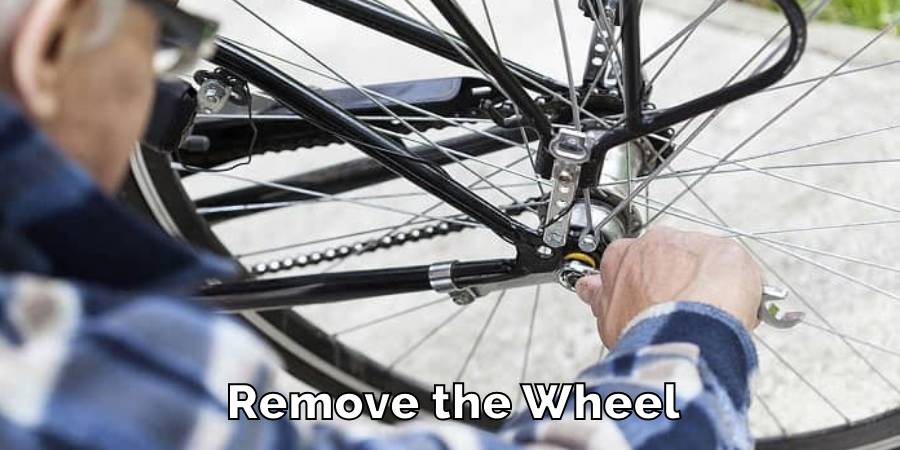
Take Off the Old Tire and Tube
Use tire levers to pry the tire away from the rim and pull out the old tube.
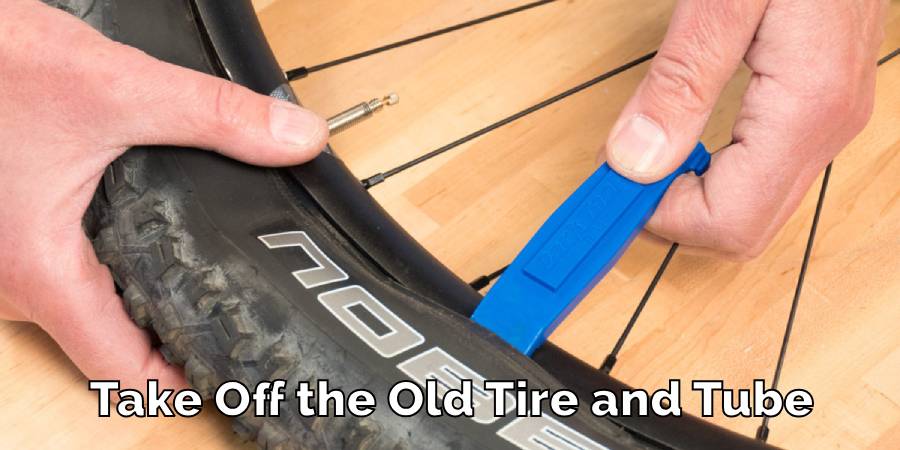
Check for Damage
Look inside the tire for things that could puncture the new tube, like thorns or glass. Also, check the rim for any sharp edges or damage.
Install the New Tube and Tire
Slightly inflate the new tube to give it shape, insert it into the tire, and then ease the tire back onto the rim.
Reattach the Wheel
Once the tire is on and properly seated, put the wheel back on the bicycle. If it’s a quick-release wheel, tighten the lever back up. If it’s a bolted wheel, screw the nuts back on tightly.
Following these steps will help ensure that you replace your bicycle tire correctly, so you can get back to riding without any issues.
Precaution While Replacing a Bicycle Tire
When you’re fixing up a bicycle tire, staying safe is the most important thing. Before you start, make sure your bicycle won’t move around — you can turn it upside down and rest it on the seat and handlebars. Always use your tools the way they’re meant to be used.
Tire levers are for prying the tire off, not for anything else that might break them or hurt your hands. Watch out for anything sharp like wires or glass from the old tire or around your workspace, because these can cut you or poke a hole in the new tube.
Once the new tire is on, press it all around and look closely to see that it’s sitting right on the wheel’s rim. If it’s not even, it could pop off when you’re riding, and that’s dangerous. Pump the tire up a little and check again to make sure everything looks good before you pump it up all the way.
Doing all this keeps you and your bicycle safe, so you can head out for a ride without any worries.
FAQs
How Often Should Bicycle Tires Be Replaced?
It depends on how much you ride and the conditions you ride in, but a general rule is to replace your bicycle tires every 1,000 to 3,000 miles. If you ride over rough terrain, you might need to do it more often.
Is Replacing a Bicycle Tire Hard?
Replacing a bicycle tire might seem like a tricky task, but it’s actually something most people can learn to do at home. The process involves removing the wheel, taking off the old tire and tube, putting a new tube in, and then putting everything back together.
You’ll need some basic tools, including tire levers, a pump, and sometimes a wrench. There are many step-by-step guides and videos online that can help you learn this useful skill.
How Do I Know If My Bicycle Needs New Tires?
Knowing when to replace your bicycle tires is key to keeping your rides smooth and safe. If you notice that the tread on your tires is really worn down (the tread is the patterned part of the tire that contacts the road), it’s time for new ones.
Other signs include seeing the underlying fabric, which looks like threads coming through the rubber, or getting a lot of flat tires. These are clear signs that your tires are worn out and need to be replaced.
What is the Life of a Bicycle Tire?
The lifespan of a bicycle tire can vary based on how you ride, where you ride, and what type of tire you’re using. On average, a bicycle tire can last from a few hundred to a few thousand miles. If you ride regularly, you might need new tires every couple of years.
It’s a good idea to check your tires regularly for any signs of wear and tear, especially before long rides.
Conclusion
Every cyclist will need to change a tire eventually. It’s an essential part of bike maintenance that impacts your safety and enjoyment. The cost of replacing a bike tire includes the price of the tire itself and, if you’re not doing it yourself, the service fee at a bike shop.
Getting to know your tires and how to change them can save you money and hassle. Regularly checking your tires and replacing them when needed keeps your rides smooth and safe.
How to Carry Bike on A Scooter?
The swift agility of a scooter with the pedal-powered pleasure of a bike isn’t just…
Where To Put Keys While Cycling?
Hey there, cyclists! Keys might seem like a simple thing, but listen up – keeping…
How to Lock Multiple Bikes Together?
Heading out with friends or family for a bike ride? Great idea! But let’s not…
How to Carry Boxes on A Bike?
Choosing your bike over a car is kind to the earth because you’re not causing…
How to Carry Musical Instruments on A Bike?
On a venture where the harmony of biking intertwines with the rhythm of music, I…
How to Carry a Yoga Mat on A Bike?
Mixing cycling with yoga offers a unique blend of benefits, including a heart-healthy warm-up from…










